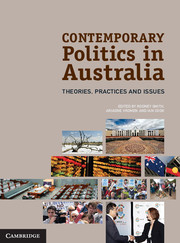Book contents
- Frontmatter
- Contents
- Tables and figures
- Contributors
- Acknowledgements
- Introduction
- I Contemporary Theories of Australian Politics
- Part II Politics in Everyday Australian Life
- Part III Elections
- Part IV Participation and Representation
- Part V Inside the Australian State
- Part VI Contemporary Public Controversies
- Glossary
- References
- Index
Introduction
Published online by Cambridge University Press: 05 June 2012
- Frontmatter
- Contents
- Tables and figures
- Contributors
- Acknowledgements
- Introduction
- I Contemporary Theories of Australian Politics
- Part II Politics in Everyday Australian Life
- Part III Elections
- Part IV Participation and Representation
- Part V Inside the Australian State
- Part VI Contemporary Public Controversies
- Glossary
- References
- Index
Summary
Australian politics is part of the curriculum of almost all political science courses in Australian universities. It is sometimes seen by students as something that they have to get out of the way in first year before they can move on to more interesting, theoretical and controversial material throughout the rest of their degrees. Some students even think that they have learnt all there is to know about Australian politics already in high school history, social science or civics classes.
The broadest aim of this book is to challenge such prejudices. Researching and studying Australian politics are not atheoretical, descriptive or uncontroversial tasks. This book promotes an understanding of Australian politics as contested ground. While the chapters in this book provide some introductory material on Australian political institutions and practices, they also introduce readers to a range of current academic theories and controversies surrounding aspects of Australian politics. Debate, scepticism and uncertainty are kept to the fore throughout. In some ways, this book may be seen as domestically oriented complement to Richard Devetak, Anthony Burke and Jim George’s An Introduction to International Relations: Australian Perspectives (2007), also published by Cambridge University Press.
- Type
- Chapter
- Information
- Contemporary Politics in AustraliaTheories, Practices and Issues, pp. xii - xivPublisher: Cambridge University PressPrint publication year: 2012



